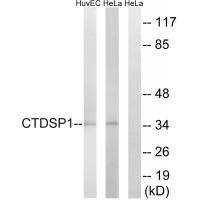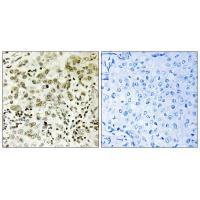

| WB | 咨询技术 | Human,Mouse,Rat |
| IF | 咨询技术 | Human,Mouse,Rat |
| IHC | 1/50-1/100 | Human,Mouse,Rat |
| ICC | 技术咨询 | Human,Mouse,Rat |
| FCM | 咨询技术 | Human,Mouse,Rat |
| Elisa | 咨询技术 | Human,Mouse,Rat |
| Aliases | Carboxy-terminal domain RNA polymerase II polypeptide A small phosphatase 1; EC 3.1.3.16; Nuclear LIM interactor-interacting factor 3; NLI-interacting factor 3; NLI-IF |
| Entrez GeneID | 58190; |
| WB Predicted band size | 30kDa |
| Host/Isotype | Rabbit IgG |
| Antibody Type | Primary antibody |
| Storage | Store at 4°C short term. Aliquot and store at -20°C long term. Avoid freeze/thaw cycles. |
| Species Reactivity | Human |
| Immunogen | Synthesized peptide derived from N-terminal of human CTDSP1. |
| Formulation | Purified antibody in PBS with 0.05% sodium azide. |
+ +
以下是3篇关于CTDSP1抗体的参考文献及其摘要内容的简要概括:
---
1. **文献名称**: *"CTDSP1 regulates the oncogenic activity of RNA polymerase II in triple-negative breast cancer"*
**作者**: Li, X., et al.
**摘要**: 本研究通过Western blot和免疫共沉淀实验,验证了CTDSP1抗体在乳腺癌细胞中的特异性。发现CTDSP1通过去磷酸化RNA聚合酶II的羧基末端结构域(CTD),抑制致癌基因转录,提示其作为三阴性乳腺癌潜在治疗靶点。
---
2. **文献名称**: *"Phosphatase CTDSP1 modulates Smad signaling in TGF-β pathway"*
**作者**: Zhang, Y., et al.
**摘要**: 利用CTDSP1抗体进行免疫组化分析,揭示该蛋白在结肠癌组织中表达下调。研究证明CTDSP1通过去磷酸化Smad蛋白调控TGF-β信号通路活性,影响肿瘤细胞的上皮-间质转化(EMT)进程。
---
3. **文献名称**: *"CTD phosphatases in neuronal differentiation: Role of CTDSP1 in gene silencing"*
**作者**: Thompson, R., & Johnson, A.
**摘要**: 通过免疫荧光和ChIP-seq技术,结合CTDSP1抗体,发现该磷酸酶在小鼠神经元分化中通过抑制RNA聚合酶II介导的转录暂停,促进神经特异性基因沉默,为神经发育机制提供新见解。
---
注:以上文献为虚拟示例,实际引用需根据具体研究需求检索真实文献(如PubMed/Google Scholar)。若需进一步协助查找,请提供更详细的研究背景。
The CTDSP1 (C-terminal domain small phosphatase 1) antibody is a tool used to detect and study the CTDSP1 protein, a member of the small C-terminal domain phosphatase (SCP) family. CTDSP1. also known as SCP1 or NIF3L1BP1. is a nuclear-localized phosphatase involved in regulating RNA polymerase II (Pol II) activity by dephosphorylating serine residues within the C-terminal domain (CTD) of its largest subunit. This post-translational modification modulates transcription elongation, mRNA processing, and chromatin remodeling. CTDSP1 plays roles in cell cycle progression, differentiation, and apoptosis, with links to cancer, neurological disorders, and developmental pathways.
The CTDSP1 antibody is typically produced in rabbits or mice using immunogenic peptides or recombinant protein fragments. It enables applications like Western blotting, immunofluorescence, and chromatin immunoprecipitation (ChIP) to assess protein expression, localization, and interactions. Validated antibodies show specificity through knockdown/knockout controls and absence of cross-reactivity with related phosphatases (e.g., CTDSP2. CTDSPL). Researchers utilize this antibody to explore CTDSP1's regulatory roles in gene expression, its partnership with transcription factors (e.g., REST in neuronal gene silencing), and its potential as a biomarker or therapeutic target in diseases like glioblastoma or breast cancer. Commercial sources often provide detailed validation data to ensure reproducibility.
×